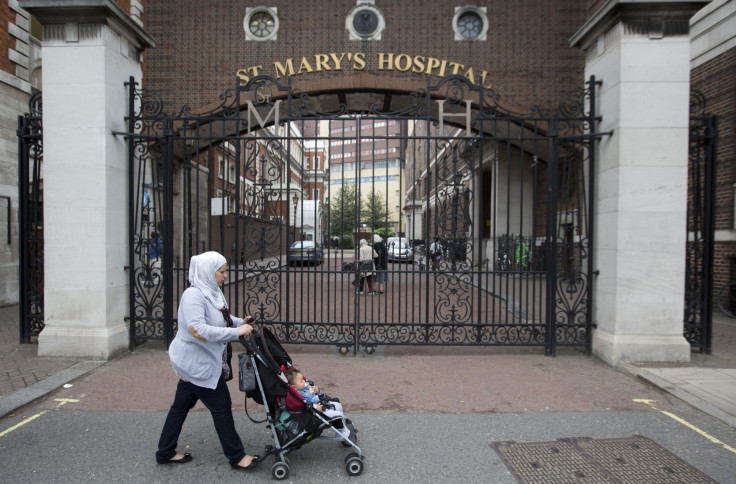Duchess Of Cambridge In Labor: Boy Or Girl, Britain’s Royal Baby To Be Third In Line To Throne

As millions of people in the United Kingdom and across the world anxiously await the arrival of the first-born child of the Duke and Duchess of Cambridge, some are wondering where the new infant will fit in the line of succession to the British throne. As it turns out, the new bundle of joy (whether it is a boy or girl) will automatically become third in line, behind its grandfather, Charles, Prince of Wales, and its father, Prince William. The baby’s uncle, Prince Harry (younger brother of William), slips to fourth place. In the event that William and Kate have more children in the coming years, Harry’s place in line would fall even further.
In October 2011, the British government, with the approval of other Commonwealth nations, like Canada and Australia, that still have the monarch as their head of state, changed the rules of succession to give female heirs equal rights to their male counterparts. In prior decades and centuries, a male heir (even if he was younger than his sister) would have taken precedence. The current Queen Elizabeth II ascended to the throne in 1952 only because she had no brothers.
Prime Minister David Cameron advocated for a change in the succession laws. At that time he declared: "The idea that a younger son should become monarch instead of an elder daughter simply because he's a man ... this way of thinking is at odds with the modern countries that we've all become.” Cameron added: “Put simply, if the Duke and Duchess of Cambridge were to have a little girl, that girl would one day be our queen.”
The changes instituted in 2011 also allowed, for the first time in three centuries, future heirs to the throne to marry Catholics without sacrificing their succession. However, the rules regarding Catholics remains muddled since the reigning monarch would still be in communion with the Church of England and serve as titular head ("supreme governor") of that church. Thus, it seems unlikely that a Catholic could become king or queen under these circumstances.
Moreover, the change in primogeniture law is not retroactive, meaning that Prince Charles’ younger sister, Princess Anne, and her children, will not skip ahead in the line of succession with respect to her younger brothers, the Duke of York (Prince Andrew) and the Earl of Wessex (Prince Edward).
In addition, the blessed infant will be granted the title His Royal Highness Prince of Cambridge (for a male issue); or Her Royal Highness Princess of Cambridge (for a female). This was a change effected by Queen Elizabeth herself.
Meanwhile, photographers and ordinary fans are camped outside St. Mary's Hospital in London – the same hospital where Prince William and Prince Harry were both born – for the impending birth. Britons are wondering not only about the gender of the baby, but also its name. Oddsmaker William Hill has a baby girl with names like Alexandra, Charlotte, Elizabeth, Diana and Victoria (all but Diana the names of previous queens) as the most likely. For a boy, George and James (both names of past kings) rank highest.
But if the new child is indeed a princess, some members of the Commonwealth might not accept her as the legal heir to the British throne.
In a Commonwealth summit in October 2011, the premiers of 16 countries where Queen Elizabeth still reigns as head of state, including Australia, Canada and New Zealand, agreed in principle to end the law of male primogeniture. However, the changes in law must be uniform in all countries, otherwise the true royal ruler will not be set in stone (that is, different states could have different monarchs based on their particular legislations).
Already, opposition to the change in the law has been offered by entities in Quebec, Canada, and Queensland in Australia. For example, in Quebec, which is largely French-speaking, a court case has challenged the way the Canadian Parliament passed a law to agree to the succession changes.
“It's a pretty complicated operation in which 16 countries in all have to change their law or their constitution," Robert Hazell, director of the Constitution Unit at University College London, told Agence France-Presse. "What the British government hopes is that the other countries may have changed their laws by the end of this year or at the latest over the next 12 months, but it's taken them a long time already. If they had a girl and then a boy and if the new law had not been brought into effect, then the boy would be next in line to the throne, so it's not secured yet."
This is the current line of succession to the throne (prior to the birth of the baby): The Prince of Wales (Charles); Prince William of Wales; Prince Henry of Wales (aka, Harry); The Duke of York (Prince Andrew); Princess Beatrice of York (Andrew’s elder daughter); Princess Eugenie of York (Andrew’s younger daughter); The Earl of Wessex (Prince Edward); Viscount Severn (Edward’s son); The Lady Louise Windsor (Edward’s daughter); The Princess Royal (Anne); Mr. Peter Phillips (Anne’s son) and Miss Zara Phillips (Anne’s daughter).
© Copyright IBTimes 2024. All rights reserved.





















